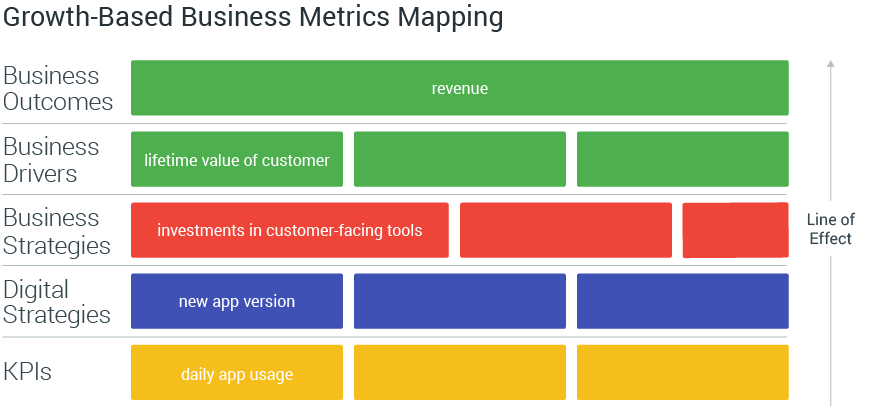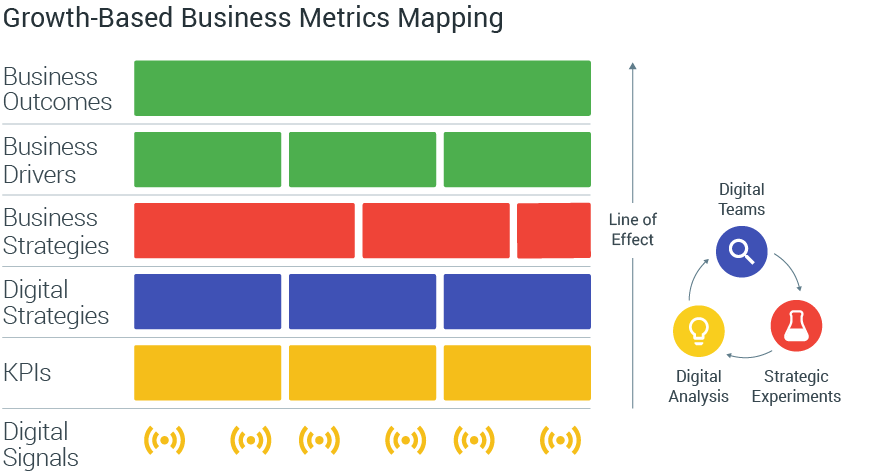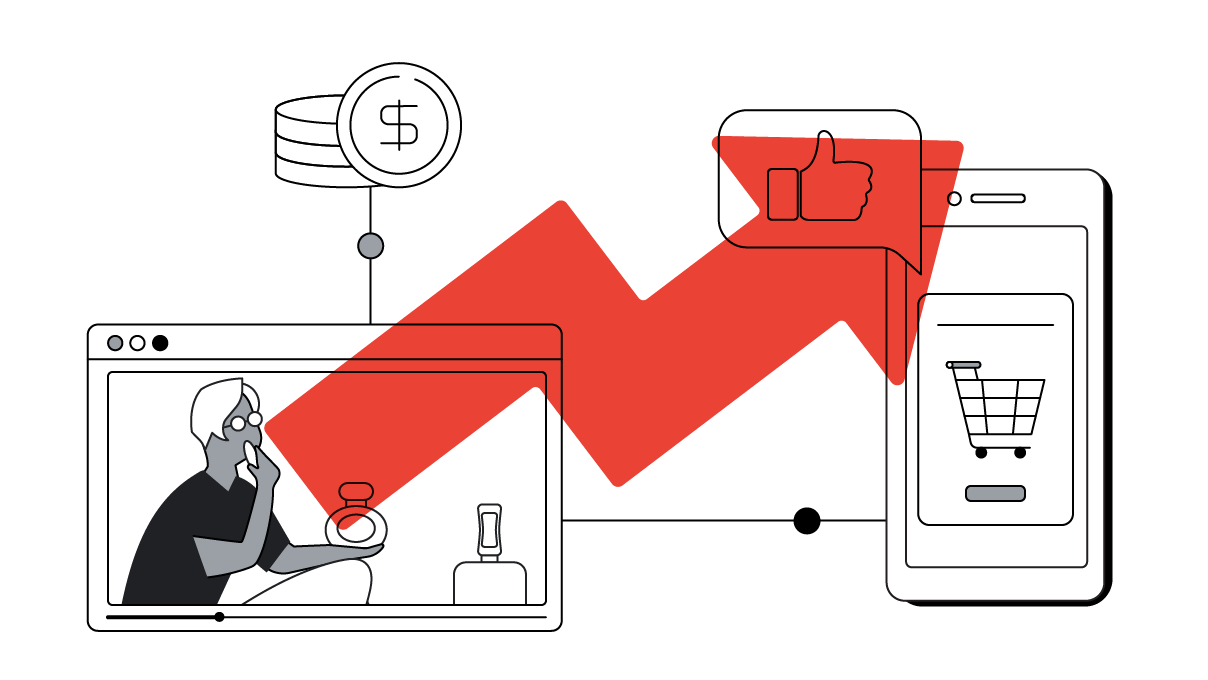Brands today can measure everything from product consideration among dads aged 35–55 to the lifetime value of a customer. But making good business decisions is more than just having the right numbers—it requires the art of experimentation and the agility of a startup. Here are our best practices for proper measurement.
Thought experiment: Your company is about to release a new version of its mobile app. It’s loaded with new bells and whistles for customers, has been tested and approved, and is all ready to go. Just before launch, an executive asks you for a plan for measuring the new version’s direct impact on revenue. Record scratch.
Does your company have systems in place to measure high-level objectives against your major business initiatives? If you’re like most companies, connecting revenue to individual tactics is probably an ongoing struggle that keeps your CFO (and a few others) up at night.
The challenge of measurement raises tough questions, and everyone in the industry is working on the answers. Here we’ll take you through some best practices and ways of approaching the questions like startups do. Startups have to meet defined, measurable goals to continue securing funding all along the way. If they can’t prove that what they’ve done has worked or will work, they’ll run out of funds in no time. And that makes them rigorous and dedicated to measuring what matters.
Creating a clear line of effect from strategies to business outcomes
The first step in effective measurement is being very clear about your desired business outcomes and what drives them. This may seem obvious, but for many companies, it remains a struggle. For most, top-line outcome is revenue. If that’s the case, then business drivers will include things like total number of customers, products per customer, delivery cost per order, and lifetime value of customers.
The next layer consists of the business strategies and digital strategies that influence those drivers up or down. These strategies are really the nature of how businesses work. They involve things like how resources are allocated for overall marketing budgets, marketing and sales personnel, new products, and improved features. Each one of these strategies has key metrics or benefits it is trying to hit.
Take a look at how this all fits together with our app release example in mind

Just by having all of these elements clearly mapped out, you’re setting your business up for success. In a Forrester study commissioned by Google, 53% of survey respondents who identified as “sophisticated marketers” stated that they adhere to well-established metrics that tie directly to business objectives. The kicker: these marketers support organizations that are at least 3X more likely to hit their goals than other marketing organizations.
Key considerations for your brand:
- Figure out the business outcomes you care about.
- Make a hypothesis about the right KPIs to measure those outcomes.
- Conduct a retrospective on each experiment.
Ensure your digital delivery team can experiment and iterate quickly
This is where things get exciting. Once you have KPIs defined to a sufficiently detailed level, you can attempt to map your analytics signals back onto your business drivers. Here’s an example: If your analytics show that brand consideration rises shortly after the launch of a new campaign, then you can infer that those specific business and digital strategies are working. But—this is the important part—if your total number of customers isn’t growing, you may have the wrong analytics signals or KPIs in place.
Here’s how it all looks together:

Successful digital teams come up with multiple hypotheses and test them out regularly. Test what strategies influence which key metrics, then see whether those move drivers or outcomes. Iterating quickly and efficiently will help your teams start to create a living map of the business and how it all works together. The ability to be nimble and test everything is crucial in a digital world where change is constant. New technologies, competitors, and consumer behaviors disrupt your marketplace on a continual basis, meaning that your living map will need to be tested and evolved over time.
Airbnb, an example of a wildly successful startup, has a system for making what it calls “customer-driven decisions.” After analyzing a particular problem, the team rolls out a controlled experiment and then identifies the causal impacts of its efforts. If successful, the change gets rolled out to the whole community. If not, data scientists take what they learn and go back to the drawing board.
If we think back to the example of releasing new versions of an app, a culture of experimentation would allow the team to approach each new version as a test. Each version can be tested against whether outcomes all the way up the living map, including lead and lag indicators, got better or worse. Those lessons can inform future launches and even redefine your key metrics for success.
Key considerations for your brand:
- Recognize that not every marketing dollar can be measured perfectly.
- Don't fixate on efficiency metrics and optimization.
- Look at digital's holistic contribution to business results.
Continuous experimentation allows for nimble pivots and better results
Instincts are hugely important, and for data-driven brands, data can augment and inform those instincts. In the case of our new app release, executives can and should be empowered to pivot direction or cancel new releases if the numbers don’t add up. In other words,“beware the hippo,”—that is, the highest-paid person’s opinion. Experiments provide valuable information about what works (and what doesn’t), and with that data in hand, executives can save their businesses from bad strategies and investments—and be better equipped to make profitable decisions.
Also key in this process is making sure that the right people have the right data at the right times. Spotify, for example, gives its “squads” a great deal of autonomy. Squads are made up of team members across several different functions, and they have end-to-end responsibility for everything they do. Instead of keeping data in one section of the company and decision makers in another, squads can work together to make data-driven decisions that ladder up to the business outcome objectives of the company.
A common challenge as businesses grow is ensuring that everyone has a holistic view of how different business strategies work in concert to achieve the business’s overall goals. Breaking down silos and teaming up different departments early in the process can help team members broader their view and make more informed decisions.
Key considerations for your brand:
- Don’t rely on gut feelings; use the data to make investment decisions.
- Team up the right people early in the process.
- Test the big questions.
Whether your goal is something as big and ambitious as building a new brand or something more directly measurable, like increasing app usage or improving ROI on a campaign, remember: you can only go so far on gut feelings. When everything is a hypothesis, data can keep us brave, and more importantly, honest—and help your businesses be prepared for whatever changes will inevitably be around the corner.
To learn more, check out our free courses at Google Analytics Academy. This Ecommerce Analytics: From Data to Decisions course is a great place to start.






